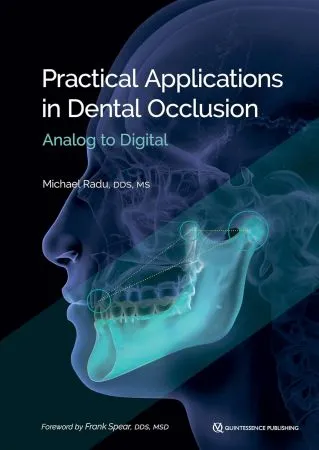Practical Applications in Dental Occlusion: Analog to Digital
Occlusion is often boiled down to the “tap, tap, and grind” of articulating paper marks dentists perform daily. Appointments are littered with fillings, single crowns, bridges, or more extensive fixed prosthodontics work.

And for 90% of those appointments, occlusion can be largely ignored until it’s time to get out the articulating paper at the end of the appointment. Tap, tap, and grind. Drill the red marks.
However, sometimes the patient’s current bite won’t allow the necessary treatment, and a new occlusion must be built and transferred to the lab.
But how?
Should the patient determine the maxillomandibular position (ie, show where they feel comfortable), or should scientific principles be applied to find the physiologic maxillomandibular relationship? How do you capture the new occlusion for the lab?
That’s where this book comes in—to teach you a simplified concept of occlusion that can help you perform predictable and successful treatment.
The book is divided into two parts: Part 1 outlines guiding principles and a simplified model of occlusion, and Part 2 features specific situations you will come across as you diagnose, treatment plan, and treat your patients’ cases.
Author Michael Radu breaks everything down and offers explanatory analogies to help you conceptualize the principles of occlusion in a way you can understand and apply to daily practice for the benefit of your patients. 210 illustrations Contents: 1.
Why Do We Need Occlusion? 2. Practical Principles of Occlusion 3. The Occlusion Formula 4. There Are Only Two Bites 5. Clinical Techniques and Principles of Interocclusal Recordings 6. Techniques for Examination and Treatment Planning 7. Techniques for Interocclusal Registration of an Existing Occlusion 8. Techniques for Interocclusal Registration for a New Occlusion 9. Techniques for Equilibration of the Occlusion 10. Techniques for Recording the Envelope of Function 11. Techniques for Communicating with the Laboratory 12. Analog Versus Digital Techniques for Interocclusal Registration Notes
English | 2024 | ISBN: 164724126X | 202 pages | True PDF | 5.5 MB
Download
*
Occlusion is often boiled down to the “tap, tap, and grind” of articulating paper marks dentists perform daily. Appointments are littered with fillings, single crowns, bridges, or more extensive fixed prosthodontics work.

And for 90% of those appointments, occlusion can be largely ignored until it’s time to get out the articulating paper at the end of the appointment. Tap, tap, and grind. Drill the red marks.
However, sometimes the patient’s current bite won’t allow the necessary treatment, and a new occlusion must be built and transferred to the lab.
But how?
Should the patient determine the maxillomandibular position (ie, show where they feel comfortable), or should scientific principles be applied to find the physiologic maxillomandibular relationship? How do you capture the new occlusion for the lab?
That’s where this book comes in—to teach you a simplified concept of occlusion that can help you perform predictable and successful treatment.
The book is divided into two parts: Part 1 outlines guiding principles and a simplified model of occlusion, and Part 2 features specific situations you will come across as you diagnose, treatment plan, and treat your patients’ cases.
Author Michael Radu breaks everything down and offers explanatory analogies to help you conceptualize the principles of occlusion in a way you can understand and apply to daily practice for the benefit of your patients. 210 illustrations Contents: 1.
Why Do We Need Occlusion? 2. Practical Principles of Occlusion 3. The Occlusion Formula 4. There Are Only Two Bites 5. Clinical Techniques and Principles of Interocclusal Recordings 6. Techniques for Examination and Treatment Planning 7. Techniques for Interocclusal Registration of an Existing Occlusion 8. Techniques for Interocclusal Registration for a New Occlusion 9. Techniques for Equilibration of the Occlusion 10. Techniques for Recording the Envelope of Function 11. Techniques for Communicating with the Laboratory 12. Analog Versus Digital Techniques for Interocclusal Registration Notes
English | 2024 | ISBN: 164724126X | 202 pages | True PDF | 5.5 MB
Download
*